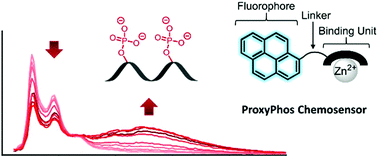Structure–activity relationship study of ProxyPhos chemosensors for the detection of proximal phosphorylation and other phosphate species†
Abstract
Chemosensors for the detection of phosphate-containing biological species are in high need. Detection of proximally phosphorylated sites of PPi and those found in peptides and proteins has been demonstrated using chemosensors containing pyrene, as a fluorescent reporter, and a Zn2+-chelate, as a phosphate-binding group. Using these sensors, detection of proximal phosphate groups is afforded by binding of at least two of the sensor molecules to the adjacent phosphates, via the Zn2+ centres, leading to excimer formation between the pyrene groups and the corresponding shift in emission from 376 to 476 nm. Although several reports of this chemosensor class have been made, no detailed studies of selectivity of these sensors among major phosphate targets have been reported. In this study, a library of this class of chemosensors, termed ProxyPhos, which contained various linkers and Zn2+-chelating groups (i.e. DPA, cyclen and cyclam), was prepared and the effects of structural variation on the sensing efficiency and selectivity were evaluated among proximally phosphorylated peptides, proteins, nucleotides, Pi and PPi. As a result of this study, we have identified ProxyPhos library members that are most suitable for the detection of proximally phosphorylated peptides, PPi, UTP, and a DpYD peptide motif, and have generally provided a foundation for the selection of ProxyPhos chemosensors for further development of specific biologically relevant assays. The broad utility of ProxyPhos is further supported by the demonstrated lack of these sensors’ cytotoxicity, ability to rapidly permeate into live and fixed cells and compatibility with gel staining methods.



 Please wait while we load your content...
Please wait while we load your content...